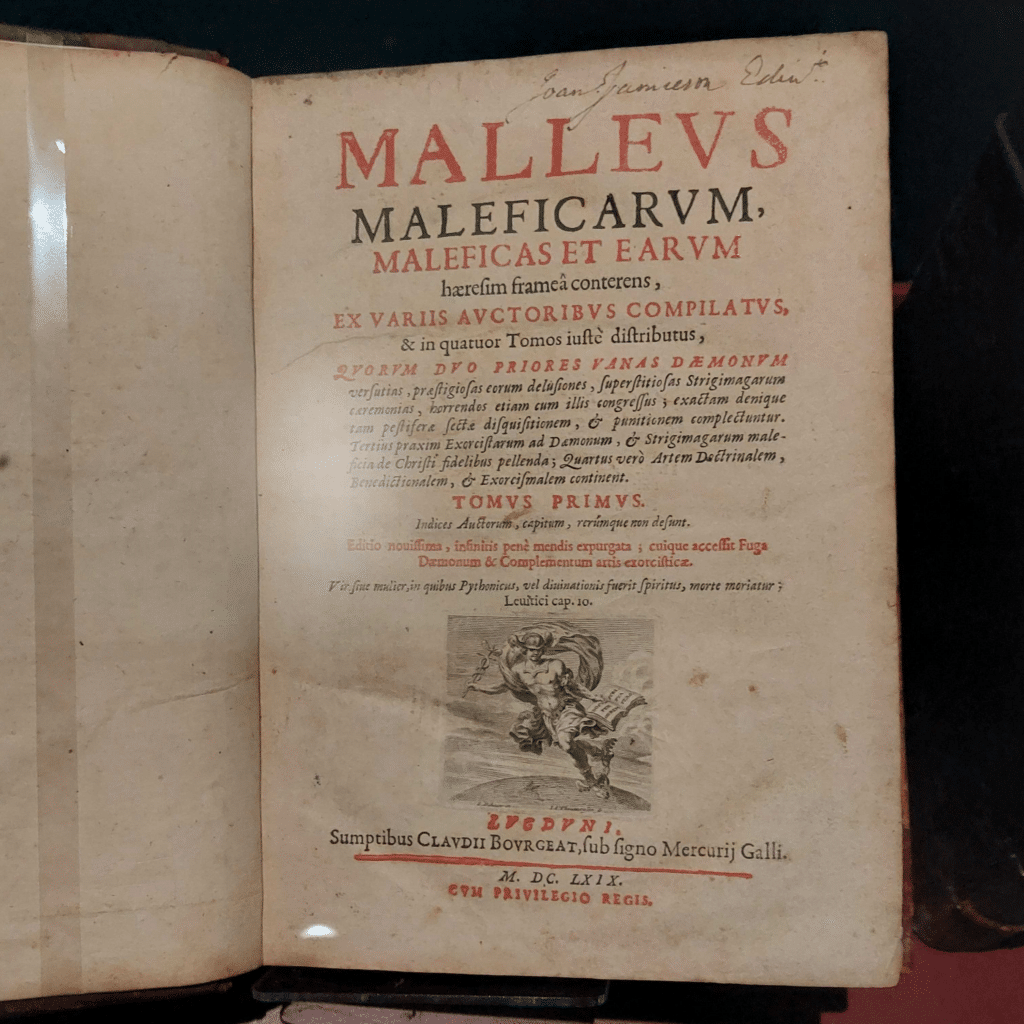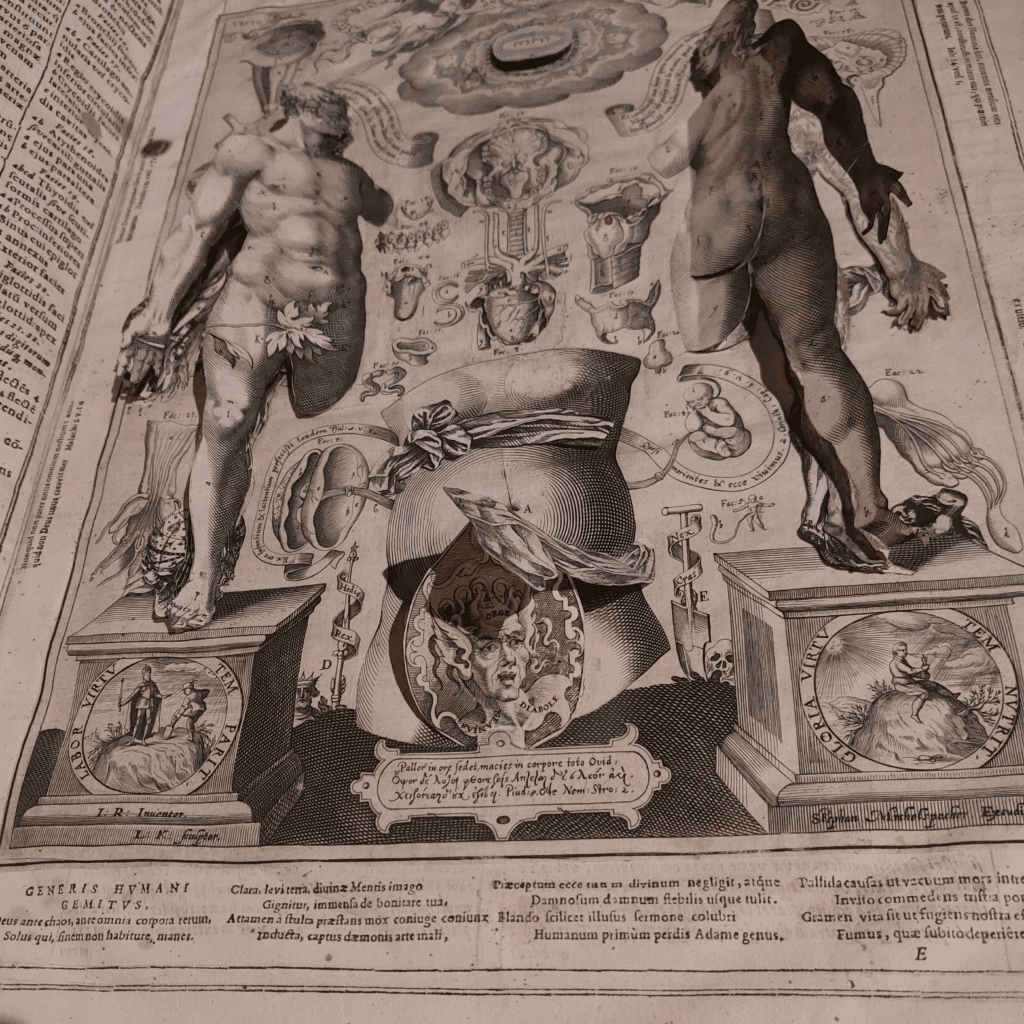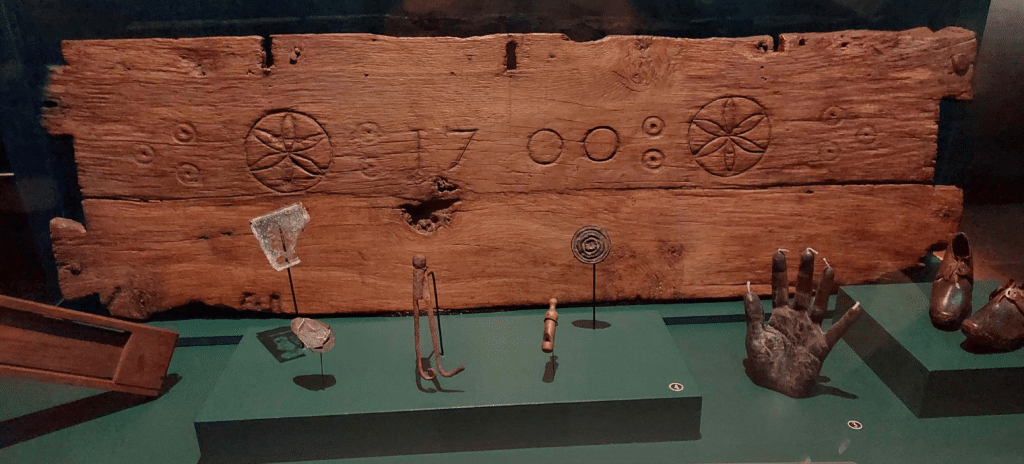The feature image is a medieval miniature depicting the torture and execution of women convicted of witchcraft.
As we recover from Halloween festivities, I’m thinking of witches. This week I visited an exhibit currently on display at the Pointe a Calliere Museum of Archaeology and History in Montreal called Witches–Out of the Shadows.
I was looking for Halloween fun, but most of the exhibit was a very serious history from the Middle Ages.
It was an eye-opening glimpse into a long historical arc of religiously-justified violence against women. The exhibit was dimly lit and quiet; it felt sacred like a tomb or memorial. I learned that between 1560 and 1630, 50,000 individuals, mostly women, were executed by church and civic courts for witchcraft throughout Europe. They were usually burned or hung. Many of them were tortured first to force confessions. A major purpose of this exhibit was to reveal witch trials for what they really were: misogyny, hysteria, and murder. The vocabulary and concepts used immediately spoke to familiar Mormon feminist experiences, and I knew I’d be drawing comparisons throughout my visit. This post compiles some of what I learned. Quoted text is from the exhibit.
“Witch trials helped to tighten political control over the populace and encouraged idealized social and religious behaviors.” Witchcraft was defined and legislated by male church authorities and magistrates. Their perceptions, codified and disseminated in numerous texts, were much more myth than reality. The underlying motivation for trials was to control and scapegoat women. The whole movement was empowered and perpetuated by what the exhibit identified as “patriarchal rhetoric.” I viewed several books clergy and other leaders used to identify and convict witches. The one pictured here, Malleus Maleficarum, was especially misogynistic and influential. It was used to convict women for two hundred years.

“At the time, women were believed to be more susceptible to temptation by the devil.” This is one of the central themes of the text above. Misogynistic readings of the Adam and Eve narrative were the central justification for assertions of women’s spiritual inferiority. Witch hunters’ intent was to protect Christendom from women who adhered to Satan’s will. The idea of magic had been around for a long time. For hundreds of years, “cunning folk” and wise women, largely folk healers, were tolerated and respected. Things changed when church authorities started to conflate the power of magic with that of Satan. Witch trials waged war against the devil’s efforts to wreck havoc on earth through (mostly) female servants.
While our church upholds fairly Eve-positive readings of the Garden of Eden narrative, it also propagates archaic thinking about women’s agency and their supposed dependence and weakness. Like medieval predecessors, Latter-day Saint leaders frequently associate women’s autonomous thoughts and feelings with the deceptions of Satan. Last spring, during the Relief Society anniversary worldwide gathering, leaders counseled women that if they feel discontent with what they are offered in their religious lives, this is likely due to Satan’s influence. This idea isn’t scripturally based, nor is it given to males. This messaging teaches women to distrust their spiritual intuitions and desires, and it assumes they need paternal monitoring. To provide another example, a woman I’m acquainted with recently told her bishop she wouldn’t be coming back to Church. The bishop bemoaned how she was being seduced by Satan’s lies. She experienced things very differently. Her bishop regularly exhibited behaviors she considered misogynistic, one of the reasons she lost interest in attending.
Witch hunts were a way to eliminate women who were gifted, leader-like, and prophetic. Joan of Arc experienced visions and other revelatory experiences. Angels and saints sent her messages from God about a special role she needed to play to help France. She was brought to trial before a church court. Her captors treated the messages she had been following as demonic, and partly because of these assumptions, she was burned at the stake. This painting from the exhibit depicts her execution.

Joan of Arc’s story reminds me of the Church of Jesus Christ of Latter-day Saints’ history of excommunicating women for bringing feminist concerns to the forefront. Such excommunications have followed a comparable impulse to get rid of women whose ideas threaten male agendas. In some cases, Latter-day Saint feminists and scholars have been disciplined for following personal revelation. For example, Maxine Hanks, excommunicated in 1993, has shared her story about how she compiled and edited Women and Authority thanks to divine revelation. Through such excommunications, the Church communicates that women’s revelations are not welcome additions because such content challenges male preferences and power. Leaders treat women’s revelations as something like hysteria or the influence of Satan. This is a symptom of misogyny and it shows a lack of intellectual humility.
Sometimes women have been disempowered by the Church in other ways. The First Presidency disfellowshipped Linda King Newell and Valeen Tippetts Avery after they published Mormon Enigma in 1984. Leaders disapproved of its unconventional portrayal of Joseph Smith’s life. The writers had fulfilled a cherished goal to research and publish an accurate historical account of Emma Smith’s life. International outcry over punishing scholars checked Latter-day Saint authorities and the discipline was withdrawn.
In the Middle Ages, women were regularly considered witches if they were invested in female bodies and relieving their suffering. Sometimes women were punished because they were so skilled in nature-based medicinal arts and remedies, including for childbirth. Many of them were midwives. Religious authorities devalued and were suspicious of their efforts to relieve female suffering. Much of their superstition about witchcraft in general centered on worries that cunning women would intentionally harm fertility, births, and babies. Ironically, in their paranoia, churches and villages rid themselves of the women who helped these causes the most. Older women and widows were targeted most frequently because they had more life experience and independence and were more likely to fill healing and caregiving roles.
The LDS Church has ignored and invalidated women’s work to relieve female suffering. Our wise women and feminist thinkers have been treated as if their work is by default suspicious or not worthy of consideration. I remember hearing Carol Lynn Pearson share on a podcast or post about how she sent a copy of her feminist treatise The Ghost of Eternal Polygamy as personal gifts to each member of the Quorum of the 15 (I apologize that I can’t find this source now). Her book shares hundreds of witnesses to the spiritual abuse and pain that continue today due to polygamy doctrines. Yet Pearson received no response from leaders, and the Church does not appear to have considered any of her recommendations for remedying women’s suffering.
Witch trials benefited churches financially at the cost of making women vulnerable and disposable. Witch hunts were a way for churches to reap profits. Church agents claimed the personal properties of women whom they executed. Starting after the reformation, churches also used trials and executions as “perverse advertisements” to gain patrons. In some cases, villages took advantage of the option to target women they disliked. “The slightest hint of collusion with Satan, either from accusation or from mere rumors, could lead to an investigation.” Offending authorities or neighbors could put a woman’s life at stake, a reality that must have been devastating to their mental health and self-actualization.
The idea that women are sexually debauched was integrated into witch rhetoric and trials. Old sketches and paintings of witches from the Middle Ages don’t depict them wearing pointy hats and capes. Instead they show groups of naked women having orgies, partying with Satan, and harming others’ bodies. A medical textbook from the Middle Ages on display in the exhibit showed a woman’s pregnant torso, with a portrait of Satan’s face covering the female genitals. Male genitals are covered by an innocent leaf. Males projected their religiously-based sexual shame onto women’s bodies.

As Latter-day Saints today, we’re impacted by long-standing Christian attitudes of misogyny and suspicion toward women’s sexuality and bodies. We might not vilify women’s sexuality, but we are anxious about it, and we don’t give it any space. I sense we’re ill-at-ease with the idea that women are just as sexual as men, even though the fact that this is true is vital for healthy marriages. The repression of sexuality and male leaders’ scrupulosity about sexual sin seem to be underlying reasons Church leaders bear down hard on practices like garment use. It is male leaders’ biases against women’s bodies that make them intolerant of women dressing according to personal desires. The LDS Church treats the female body as something unsafe that is to be monitored by male clergy much like churches did in the Middle Ages.
Today it is obvious to see that all the thinking and periods of hysteria around witches were really just a way to gain a tighter grip over women in times of conflict and anxiety. European countries have exonerated all those murdered for witchcraft. It’s painful to witness what women suffered because of men’s irrational, anxious thinking, and men’s impulses to harm vulnerable people in order to gain a financial or religious upper hand. Below are objects created to stave off black magic and witches from the exhibit.

It is bizarre to realize that people were sincerely convinced by the goodness of their misogynistic and violent thinking. At the time, they believed they were doing the right thing for society, the church, and God. Now just about anyone can see that they oppressed and murdered the poor and the helpless, and that their anxious oppression of women only held the Western world back from progress and a more enlightened and compassionate kind of Christian faith.
Managers of the LDS Church are consciously well-intentioned and convinced of their moral uprightness. Yet they suffer from distorted thinking about women’s spiritual autonomy that is comparable to that of the Middle Ages. Hundreds of years from now, will Latter-day Saints look back at patriarchal rhetoric as irrational, anxiety-driven and oppressive? Will feminists be exonerated like Joan of Arc, who was canonized in 1920? Or, will the Saints still be convinced of the divinity of misogynistic thinking for centuries to come and dwindle in numbers? All I know is that there is a lot of cautionary content for our Church in the European history of witch trials. If our administrators humbly considered this history, it might even lead them to wonder if they are in fact the ones who have been deceived about women’s roles and needs.
Today, witches are often symbols of female emancipation and resilience. In recent decades, some feminist groups have taken up the witch as a symbol of their subversive work.
When Mormon women join feminist forces like Exponent II, we enter a space that is comparable to “Mormon Witchcraft.” There are experiences of empowerment, healing and sisterhood, but this also comes with a cost of social acceptance and ecclesiastic safety. We may be snubbed, criticized, or invited to unwanted one-on-one meetings with priesthood leaders. We may not feel safe to talk about our work with our own families.
We feminists don’t always deliberately choose this path. When a woman receives revelation that contradicts what she was always taught to believe, she may be surprised. When God inspires her to write a certain book or advocate for marginalized people, her spirituality may suddenly become autonomous and untamed in a way she did not foresee. It doesn’t always feel comfortable, but someone needs to steward these strange and beautiful woods of autonomous Mormon female thinking.






18 Responses
Such a thoughtful comparison. Thank you for writing. I highly recommend the BBC Radio 4 podcast series, Witch.
Oh, wonderful. I am so going to listen to this, thanks for the recommendation! I’m glad you like the post.
I took a class on witchcraft in medieval Europe as part of my religious studies degree and had so many thoughts, many of which you’ve shared here. One that stood out to me: the church was trying to get rid of competition. “Witchcraft,” such as it were, was another option to handle life’s problems, and the church wanted to be the only way that such issues could be handled. They were the “correct” type of magic. It was all about consolidation of power. I just started a book yesterday about a woman in the 1800s who was committed to a mental institution for going insane–evidence of her insanity is she started thinking and speaking for herself, she disagreed with her husband out loud–you know the drill. There’s a quote at the beginning that says this is basically moving along the spectrum from witchcraft to insanity. So only the methods have changed in the last millennium (and more), not the ideas about or violence against women.
@heidi would love to know the name of the book. Sounds fascinating.
@candice—great and fascinating article!
It is “The Woman They Could Not Silence,” who also wrote “The Radium Girls,” which I haven’t read but have heard very good things about. The subject is Elizabeth Packard. I am one chapter in and wildly stressed out. (Should I be reading this book five days before Election Day? Probably not.) And the actual quote, which should be shared because Roxane Gay said it, is “Unruly women are always witches, no matter what century we’re in.”
Ack, sorry–the author of the book is Kate Moore, who wrote “The Radium Girls.” Brain is faster than fingers today.
Heidi, I think your comment about the medieval church wanting to get rid of competition tracks with LDS practices. A couple years ago the Church Handbook of Instructions was updated and this was inserted: “Church members are discouraged from seeking miraculous or supernatural healing from an individual or group that claims to have special methods for accessing healing power outside of prayer and properly performed priesthood blessings. These practices are often referred to as ‘energy healing.'” Energy healing, reiki practice, etc. are commonly practiced by women. Church leaders don’t like it when women reach for alternative spiritual practices that bypass the priesthood line.
Caroline, for the first half of that quote, I was thinking “… seeking miraculous or supernatural healing … you mean like the priesthood?” Male magic is fine. Female magic is bad.
I like how you’re bringing this into practices and policies today. I wonder what the church’s attitude would be toward members practicing indigenous medicine and healing methods. I would hope they wouldn’t want to overstep into controlling native members’ spiritual intersectionality. Makes me think about how the church would probably discourage me from things like searching for animal sightings (something that is very common among native spiritual practices) and synchronicity meaning-making. Things I described in one of my last posts here: https://exponentii.org/blog/on-the-powerful-sacred-redemptive-work-of-mormon-feminist-writing/ I have an LDS friend who uses techniques she learned from a very spirituality book about how to communicate with deceased relatives in the spirit world. She’s very attuned and the methods work for her. I bet the Church wouldn’t be happy with that. One time her grandma appeared to her in a dream and told her things are so much different on the other side in the Church. Hierarchy is gone, and they aren’t caught up in lame worries or tensions or bickering, just a focus on growth and love. No wonder women’s revelations are repressed.
Heidi, thank you for sharing what you learned at university, this is really interesting. The idea that witch accusations are in the same pattern of behaviors as imposing a label of mental illness is fascinating. This history you are reading reminds me of how in the 1950s, Quebec converted orphanages into mental asylums because the province wanted to get more federal funds. The children were treated as collateral in a corrupt quest for money and power. Also reminds me of the short story the Yellow Wallpaper in which the treatment for women’s unhappiness with their lives– bedrest and isolation–made everything so much worse. A friend of mine who is UU came to my office the other day and was talking about how across faith traditions, if men have spiritual imaginations and mystical experiences, it is treated as revelation, but if women have the same kinds of experiences, it is usually considered hysteria or mental illness. We talked about how both of us happen to have had grandmothers who did indeed have serious mental suffering and struggles, but who also had revelatory experiences, even visions!
Wow, excellent post. All the made-up persecutions for witchcraft are just so, so sad, and as you point out, have so many awful parallels today.
I was particularly struck by this line you said: “Males projected their religiously-based sexual shame onto women’s bodies.” This is such a great one-line summary for the core of so much wrongheaded thinking by Church leaders (and so many other people, politicians, and so forth). Men in power see women as *embodying* sex, as though this were something unique to them. It’s hard for me to see it as anything other than a total failure of any real willingness to analyze your own thoughts: “I looked at a woman and I thought about sex, and therefore she *is* sex and needs to be controlled so I don’t have these wicked thoughts.” It’s utterly ridiculous.
Thank you, I think your description here is spot on!
This is such an incredible post, Candice. Thank you for laying this all out. I read Devil in the Shape of a Woman: Witchcraft in Colonial New England by Carol Karlsen in grad school, and it was fascinating. I don’t remember all the takeaways, but I remember that the accused women were often outspoken, poor, and/or unconnected to men (widows). Some women whom male colonial leaders suspected of witchcraft were challenging male religious authority and arguing for a significantly enlarged sphere of female activity. As you have so thoughtfully laid out, there are certainly parallels between the women that patriarchal leaders of centuries past found dangerous/in league with the devil, and the women that have been excommunicated or ostracized in modern Mormonism.
Thanks for the reading idea! While I have taken classes about the Middle Ages, this was my first exposure to scholarship about witch trials. It kind of blew my mind. Thank you so much for the kind encouragement.
Last May, my daughter and I were able to visit the Joan of Arc museum in Rouen, France, where she was killed. The exhibit was so moving and immersive, I was brought to tears. I realized not much has changed since Joan was accused, convicted wrongly, and killed. We aren’t putting women to death for being witches, but our church has its own system for silencing and punishing those who speak out and question the system.
Our stake conference is this weekend, and there is a priesthood leadership meeting before the main session on Sunday, but no meetings for women in leadership. My husband emailed the SP and asked why no women were included in leadership meetings this time around, and suggested that things like this made women in our church feel invisible. The SP replied that he was following the handbook, and that women were not included because of the topic. Can you imagine a topic that would be discussed at church that women leadership could not add value to?
Sarah, thank you so much for sharing this. This morning I was just wondering about if there is a historical spot dedicated to Joan of Arc and how much I’d like to go experience it. I’m glad that your family raised this issue. I agree, women have much needed wisdom to share on any given topic. Many stake priesthood leaders are so conditioned to not treat women as equals with pertinent things to say and act on that they don’t even sense these biased and offensive waters they are operating in. I had a meeting with a leader recently in which he would have talked the entire time without asking me anything if I had let him. We desparately need women’s inspiration to contribute if we want the church to heal and to flourish.
YES! Thank you for this. I’ve had similar thoughts. I’m interested in researching more how the LDS church’s loose definition of “apostasy” that seems to mean “publicly disagreeing with church leaders” functions in similar ways as accusations of witchcraft for controlling societies and access to power.
I’m so glad you enjoyed this post and that it overlaps with your interests. Thanks, Katie! I think this is the only blog post about witch trials so far, I’d love to see one written by you! (or something that is beyond a blog post of course).